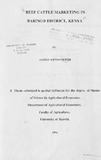Beef cattle marketing in Baringo District, Kenya
| dc.contributor.author | Serem, ASK | |
| dc.date.accessioned | 2013-05-09T14:00:36Z | |
| dc.date.issued | 1994 | |
| dc.identifier.citation | MSc. | en |
| dc.identifier.uri | http://erepository.uonbi.ac.ke:8080/xmlui/handle/123456789/20944 | |
| dc.description.abstract | The study aims at determining the factors that influence competition and pricing efficiency in the Baringo beef marketing system. It starts by describing the marketing system in the district and then goes on to show the prevailing movement patterns of cattle within and out of the district. The extent of pricing efficiency is then analyzed by looking at the returns to capital based on gross margins. The results of the analysis show that the major form of organized marketing of livestock in Baringo district is through auctions. It also shows that most of the auctions in the district have a relatively high buyer concentration and therefore low competition. It was also observed that the major barrier to entry is the high capital requirement for aspiring cattle traders. Both horizontal and vertical .integration was evident in the system as well as high returns to capital to both integrated and non-integrated traders. There was evidence of low efficiency in the Baringo beef cattle markets. The aspects of inefficiency identified were the existence of high returns to capital in virtually all the channels except that of Mogotio group of auctions for cattle that are retail sold to Nakuru. | en |
| dc.description.sponsorship | University of Nairobi | en |
| dc.language.iso | en | en |
| dc.publisher | University of Nairobi | en |
| dc.subject | Beef Cattle | en |
| dc.subject | Marketing | en |
| dc.subject | Kenya | en |
| dc.title | Beef cattle marketing in Baringo District, Kenya | en |
| dc.type | Thesis | en |
| local.publisher | Department of Agricultural Economics | en |

